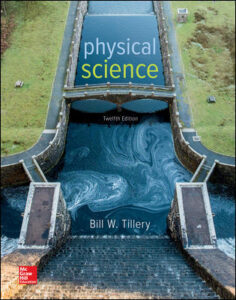Description
Test Bank For Physical Science 12th Edition By Bill Tillery
Chapter 9 Chemical Bonds
1) The breaking and making of chemical bonds can explain chemical reactions and energy flow.
2) The representative elements have one to eight valence electrons.
3) An atom becomes a positive ion by gaining an electron.
4) Atoms gain or lose electrons in chemical reactions in order to increase their energy state.
5) Atoms gain or lose electrons in order to attain a valence orbital arrangement like that of a noble gas.
6) Ionic bonds occur between atoms from adjacent groups.
7) A covalent bond is created by shared pair of electrons.
8) Three hydroxide ions are needed to form a neutral ionic compound with an aluminum ion.
9) The -ide ending in nitrogen dioxide tells you that this is an ionic compound.
10) The subscript “2” in Mg(OH)2 tells you that the charge of the hydroxide ion is (−2).
11) The smallest unit of a covalent compound that still retains the properties of the compound is called a(n)
- A) electron.
- B) atom.
- C) molecule.
- D) dipole.
12) Evidence of a chemical reaction includes
- A) a color change.
- B) a change in temperature.
- C) the production of a gas.
- D) All of the answers are correct.
13) In an ionic compound, the metal
- A) usually forms a negative ion.
- B) takes the –ide
- C) has a Greek prefix like mono, di or tri.
- D) is written first.
14) Ionic compounds are generally
- A) white, crystalline solids.
- B) gaseous substances.
- C) syrupy liquids.
- D) amorphous solids.
15) The formation of an ionic bond
- A) involves a transfer of one or more electrons.
- B) results in a release of energy.
- C) helps atoms achieve a noble gas electron arrangement.
- D) All of the answers are correct.
16) The amount of energy released when wood is burned is
- A) greater than the amount of solar energy absorbed during its formation.
- B) equal to the amount of solar energy absorbed during its formation.
- C) less than the amount of solar energy absorbed during its formation.
- D) greater or less than the amount of solar energy absorbed during its formation, depending on how it is burned.
17) Atoms that have eight valence electrons would tend to
- A) be highly reactive.
- B) be inert.
- C) form positive ions.
- D) form negative ions.
18) The formation of a positive ion
- A) occurs when an atom gains a proton.
- B) involves a release of energy.
- C) occurs when an electron is removed from an atom.
- D) occurs in covalent bonding.
19) Consider the electron dot diagram of the unknown element X:
This atom would most likely
- A) form an ion of +6 charge.
- B) react with hydrogen to form H2
- C) lose two electrons when forming an ion.
- D) form an ion of +2 charge.
20) What type of chemical bond does the sharing of a pair of electrons form?
- A) covalent
- B) ionic
- C) metallic
- D) double

Reviews
There are no reviews yet.